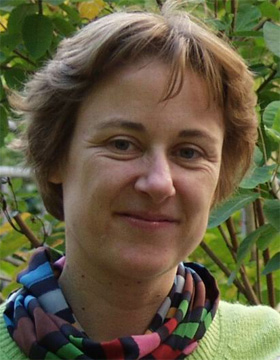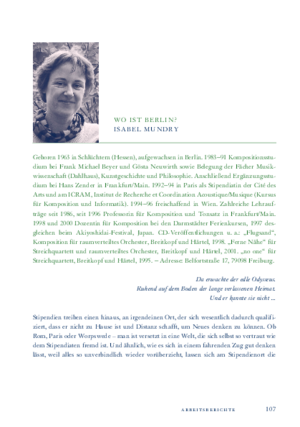
Isabel Mundry
Professor for Composition and Theory of Music, Composer
Frankfurt University of Music and Performing Arts (HfMDK)
Born in 1963 in Schlüchtern
Studied Composition at the Hochschule der Künste Berlin and at the
Hochschule für Musik und Darstellende Kunst Frankfurt a. M. and
Musicology, Philosophy and History of Art at the TU Berlin
Project
"A Breath. The Odyssey" a composition for the Deutsche Oper Berlin
Kompositorische Arbeit an einem Musiktheater mit dem Titel "Ein Atemzug, die Odyssee" für die Deutsche Oper Berlin. Die Komposition setzt sich thematisch mit dem Stoff der Odyssee auseinander, ohne diesen im strengen Sinne in eine Bühnenmusik zu übertragen. Wesentliche "Leitmotive" des Buches, wie Erinnern - Vergessen, Warten - Treiben, Suchen - Finden, Bewegung - Stillstand etc., werden auf verschiedenen parametrischen Ebenen der Oper ausgeleuchtet. Licht, Bild, Orchester, Solist, Tänzer, Chor und Raum - sie alle begeben sich in diesem Stück auf eine kompositorisch inszenierte Odyssee.Die Arbeit entsteht in enger Zusammenarbeit mit der Choreographin und Regisseurin Reinhild Hoffmann und der Dramaturgin Theresia Birkenhauer, die beide in Berlin leben. Der üblichen Trennung zwischen Entstehung der Partitur und der Regie versuchen wir entgegenzuwirken, indem bereits während der kompositorischen Arbeit Fragen der Inszenierung diskutiert werden.
Hinweis für Mit-Fellows
Ich bin prinzipiell daran interessiert, Fragen, die mich in der künstlerischen Arbeit beschäftigen, im interdisziplinären Dialog zu durchleuchten. Derzeit interessieren mich insbesondere Aspekte der Raumwahrnehmung, und ich suche strukturelle Erkenntnisse aus Vergleichen zwischen Musik, Architektur und Stadtplanung zu gewinnen.
Lektüreempfehlung
"Flugsand", Komposition für raumverteiltes Orchester, Breitkopf und Härtel 1998, CD.
"Ferne Nähe" für Streichquartett und raumverteiltes Orchester, Breitkopf und Härtel 2001.
"no one" für Streichquartett, Breitkopf und Härtel 1995.
Colloquium, 13.01.2003
The Choreography of Musical Space
Musical thinking is also always spatial thinking. Music is concerned with phenomena like density and emptiness, it measures distances and proportions, and every musical work poses the question of what constitutes a musical space in a world where noises and sounds always surround us. Here, the concept of space has always comprised several parameters of music, beginning with the characteristics of vibration in a single tone (a violin tone develops a different spatiality than a flute tone does) and with the tone's dynamics, with the heights and depths of a sound, with relations between musical elements and forms, with temporal proportions, with the array of instruments, and finally with the site of the performance: chamber, concert house, street, or headphones...
If we can trace in music history ideas of space that are inscribed in respectively unique forms in the individual works (and which often behave as dissonance in relation to the individual works), such as tone space modes in the Middle Ages and form architecture in the Baroque and Classical periods, etc., then the basic experience of contemporary composing is a spectrum-covering concept of space in which the experience of its historicity is as present as its emptiness is.
On the basis of three compositions that I wrote in past years, I would like to trace how spatial-visual impressions become intra-musical ideas that, in various ways, illuminate the phenomena of musical space.
1. The orchestral work "Flugsand" ("Wind-Borne Sand") is a spatial composition in the concrete sense that the instruments are positioned in a circle around the audience. Inspired by the photographic works of the artist Thomas Wrede, which make visible the dust tracks of birds that have flown against windows, I pursued the questions: What is the interior life of a moment? What is its site? What can be said about the presence of the moment, if its end does not simultaneously mean the end of the music?
2. The chamber piece "Traces des Moments" takes up the idea of the moment, but is primarily concerned with its temporal trace. My inspiration here was my encounter with Japanese gardens, where the range between timeless pebble formations and the chance patterns of falling leaves develops various levels of temporality that mirror each other. In this composition, a space can be equated with a measure or beat, and the latter fits within the architecture of the work like a room within its building.
3. Finally, "Solo auf Schwellen" ("Solo on Thresholds") is a spatial work for just one instrument, a trumpet with not one but two bells; the musician shifts between them with a valve. This work is primarily concerned with the phenomenon of the threshold: a transition, interstice, stumbling block, ephemeral moment, and site of change, hesitation, and sometimes fear. With a double-belled trumpet, the obvious idea is to locate the threshold between the bells, but this composition is about the fact that a threshold can arise wherever a spatial feeling dissolves - in the middle of an empty surface, when taking a step in the dark, or at the end of a tone.
Publications from the Fellow Library
Mundry, Isabel (2010)
Atem - Schrift: Gedanken zur Musik von Toshio Hosokawa
Mundry, Isabel (2008)
Bemerkungen zu Hans Zenders "Shir Hashirim"
Mundry, Isabel (Wiesbaden (u.a.), 2002)
Gefalteter Augenblick : für Orchester in 3 Gruppen ; Partitur ; [Noten]
Mundry, Isabel (Wiesbaden (u.a.), 2002)
Spiegel Bilder : für Klarinette in B und Akkordeon ; for clarinet in Bb and accordion ; [Noten] Edition Breitkopf ; 9105
Mundry, Isabel (Wiesbaden [u.a.], 2002)
Solo auf Schwellen : für Trompete mit zwei Schalltrichtern Solo auf Schwellen
Mundry, Isabel (Wiesbaden (u.a.), 2001)
Ferne Nähe : für Streichquartell und Orchestergruppen ; [Noten]
Mundry, Isabel (Adenbüttel, 2000)
Mundry, Isabel (2000)
Anagramm : für Stimme und Klavier
Mundry, Isabel (Mainz, 1999)
Le silence - Tystnaden Edition Zeitgenössische Musik

